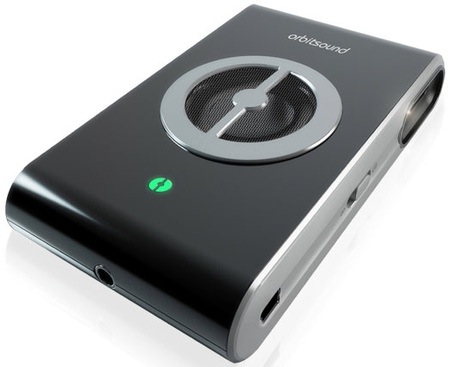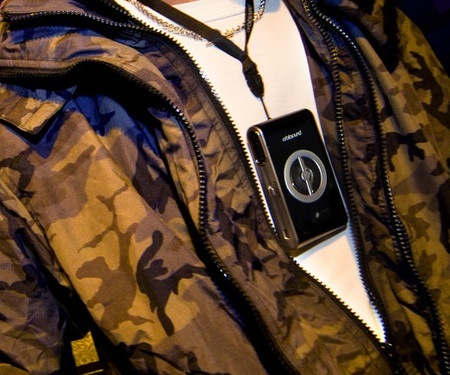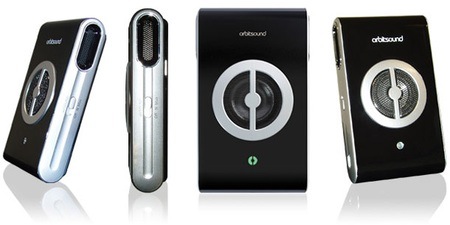Original URL: https://www.theregister.com/2008/12/02/review_speaker_mobile_orbitsound_t3/
Orbitsound T3 mobile 3D stereo speaker
Get a 3D music soundscape wherever you go
Posted in Personal Tech, 2nd December 2008 09:02 GMT
Review Music production has quite an armoury of spatial effects to tease the ears with but, typically, for the best experience, the listener needs to sit in the sweet spot. The Orbitsound range is designed to deliver a spatial soundfield anywhere in the room and now, with the T3 mobile stereo speaker, you can take that soundscape wherever you go.

Orbitsound's T3: mobile sound projector
About the size of a packet of ciggies, the T3 is quite a stylish gadget, albeit alarmingly lightweight. The central ‘main’ speaker and power indicator LED, adorn the front panel. Each side features a sound port to deliver stereo audio with the aid of a second, hidden, "coincident dipole" speaker that's mounted diagonally, effectively projecting out of the side.
If this doesn’t make much sense, don’t worry. We’ll let airSound - the company behind the Orbitsound's technology - explain its inverted approach to Alan Blumlein’s M/S (middle and side) stereophonic recording experiments in more detail here.
On one side of the fake metallic finish is the power switch and a mini USB socket that hooks up to the supplied mains charger. Alternatively, the internal lithium-ion batteries can charge from a computer’s USB interface. The other side features the airSound mode selector: Off, Normal and Max. At one end, farthest from the sound ports is the minijack input (cable included). At the other end is a loophole to thread a supplied lanyard through, enabling the Orbitsound T3 to be hung round the neck. There’s no volume control as the sound level is determined by the host device.

Volume controls unnecessary
At this point, visions of teenagers on tubes and buses blaring out their idea of music from mobiles and iPods seems a distinct possibility and, quite frankly, Hell on Earth. No doubt, this is exactly the market Orbitsound has in mind. So, it’s time to disable old git mode and give it a try.
The T3 can be used in two ways: round the neck, for a mobile sonic sensation, or on a flat surface. With the latter, the ‘surface effect’ of acoustic propagation comes into play, which effectively bolsters the T3’s sound reproduction. On a table alongside a laptop, the T3’s knack of projecting sound is evident, giving it considerable presence. Our laptop speakers, while acceptable, sounded decidedly subdued by comparison.
Whilst listening to a radio documentary on Syd Barrett, strange things began to happen as the T3 went to town on the rather crude stereo placements on Interstellar Overdrive, half of which was now playing in some seemingly impossible position behind the laptop screen. These effects certainly prick up your ears, but so does the puny bass response. Aural pleasures aside, the lack of bass does make for fatiguing listening and, after prolonged testing, it was actually a relief to turn it off.

Urban innit?
In yoof mode, with it dangling round the neck, the T3’s bass response is even more noticeable by its absence. The short lanyard keeps the T3 in close proximity to the ears and heightens the spatial projection. Purists will be pleased to note that, stereophonically, the left and right channel integrity is preserved in this position. While the T3 continues to produce startling effects and can get fairly loud before distorting - something it does with comparative ease - the fact remains that it’s just gutless. While Madonna’s Ray of Light sparkled with spatial gymnastics, it failed to throb and, like most music without a pulse, seemed dead as a result.
So what is Orbitsound trying to pull off here? The hype goes something like this: headphones send direct signals to the lugholes and don’t deliver the same spatial depth without psychoacoustic treatments. The airSound system relies more on physics than digital signal processing and, is thus, ‘purer’ and also affords the listener an awareness of the surroundings. While this may be true, headphones can deliver a decent bass response and have the advantage of insulating the listener from outside disturbances - such as some yoof dangling a distorting Orbitsound T3 on the train home.

Sound in the round
Verdict
Overall, the T3 is best on a tabletop - just remember to turn off the iTunes Sound Enhancer or the T3 will sound very brittle and nasty. Yet the impression is that this is a device that should be given away at trade shows, as proof of concept, rather than taken too seriously. After all, given its somewhat grandiose price tag of £49, you’d want it to have Bluetooth. Instead, given its woeful lack of bass, it’s a rather expensive gimmick. There could be a solution, but not one that airSound audiophile Ted Fletcher would approve of.
SRS' TruBass is a psychoacoustic system that, by using harmonics, tricks the brain into perceiving bass from small speaker systems. Combine airSound and TruBass and you might have something worth hearing. But unless Orbitsound does something to improve the T3’s bottom end, then aural excitement alone is unlikely to be to everyone’s taste. ®
More Audio Gadgets...
Motorola TLKR T7 |
Olympus LS-10 |
Bayliss Eco Player |
Logitech Boom |